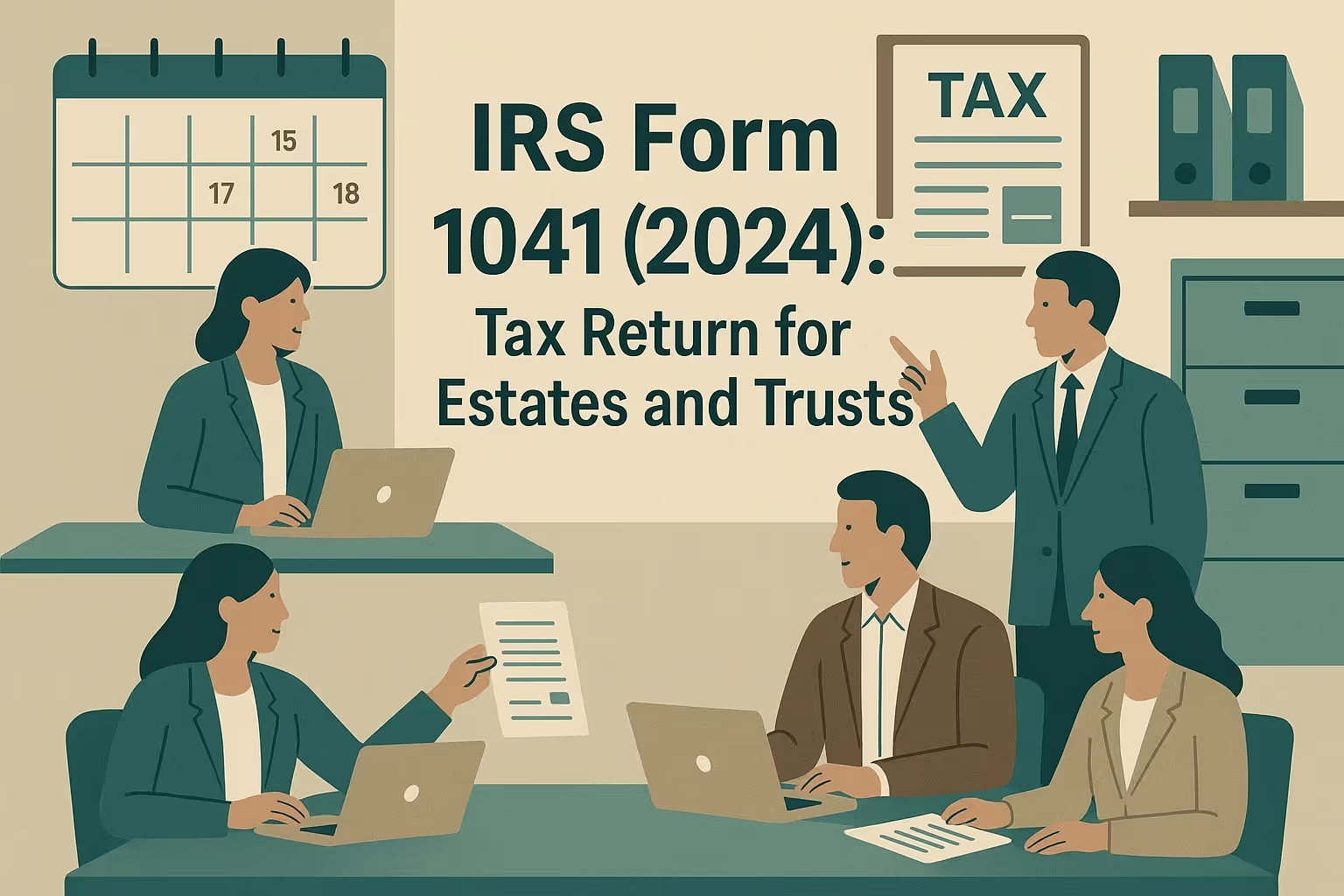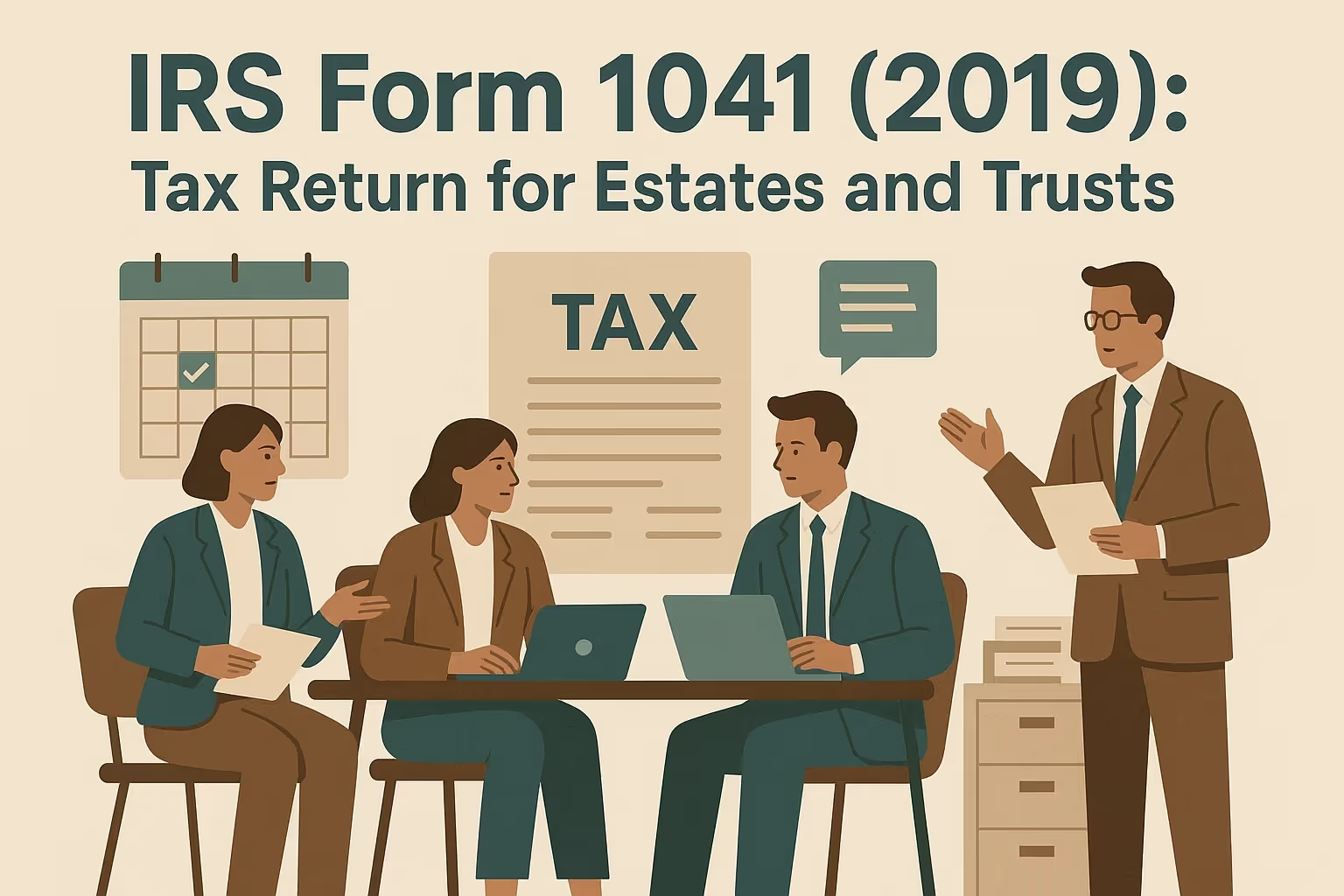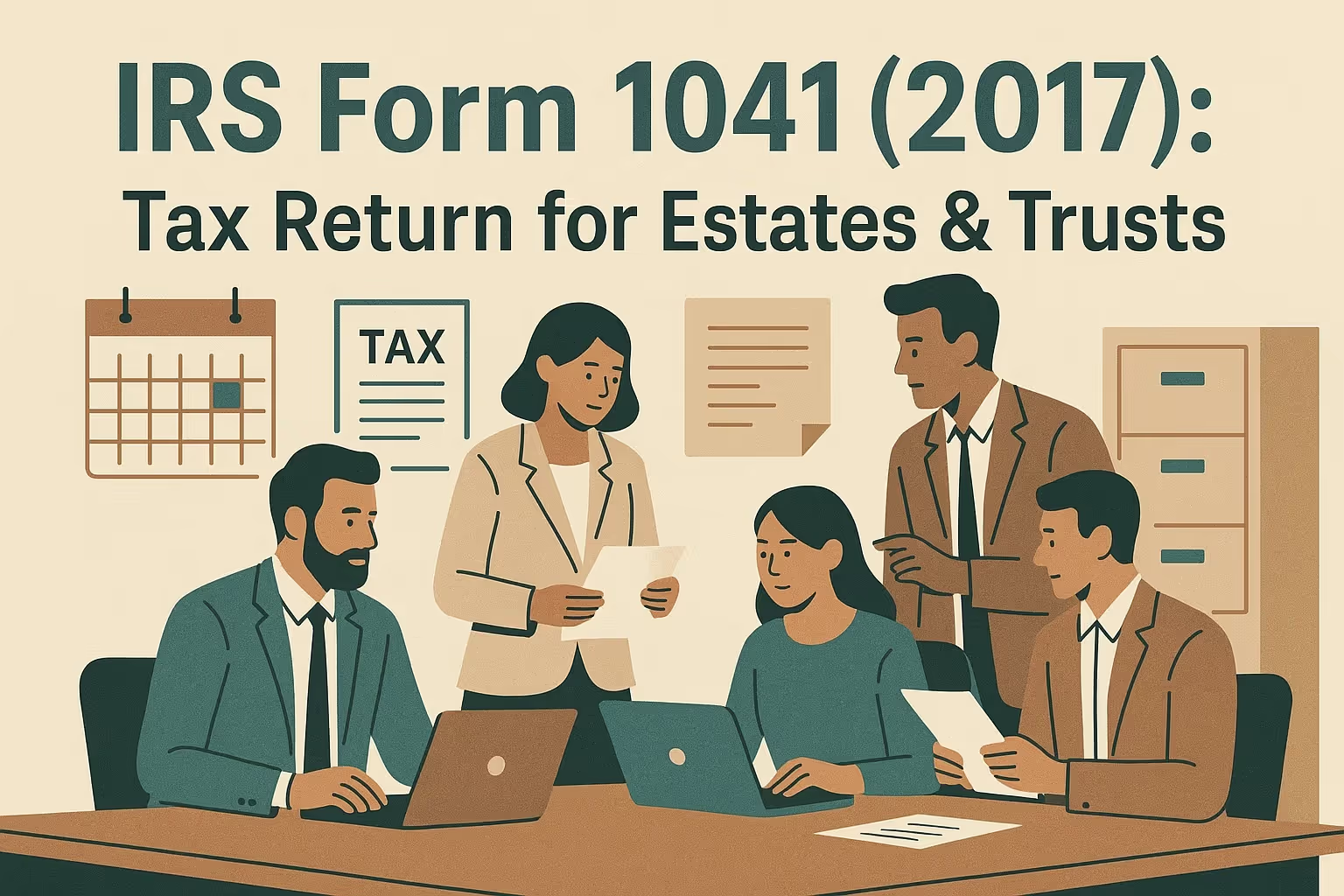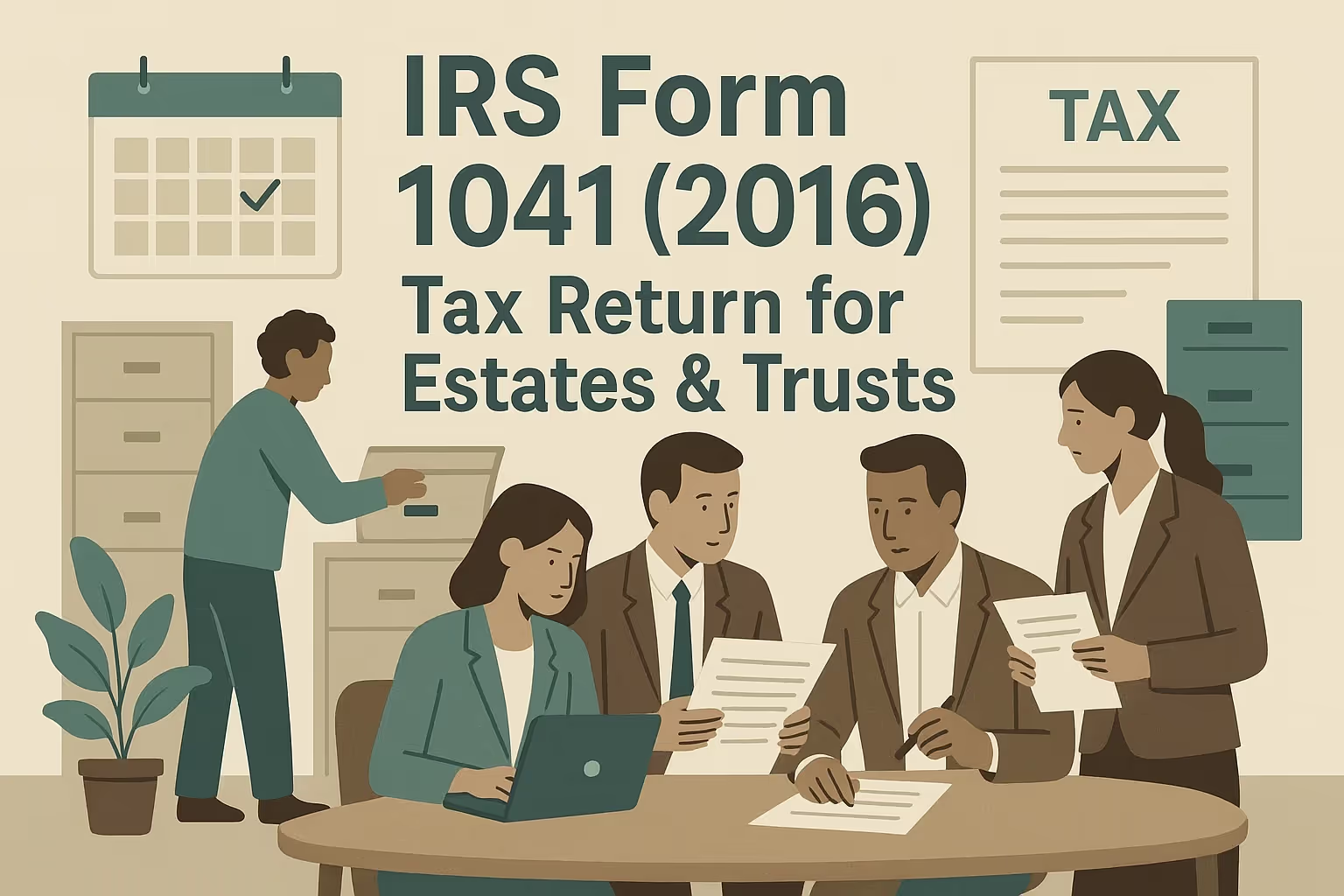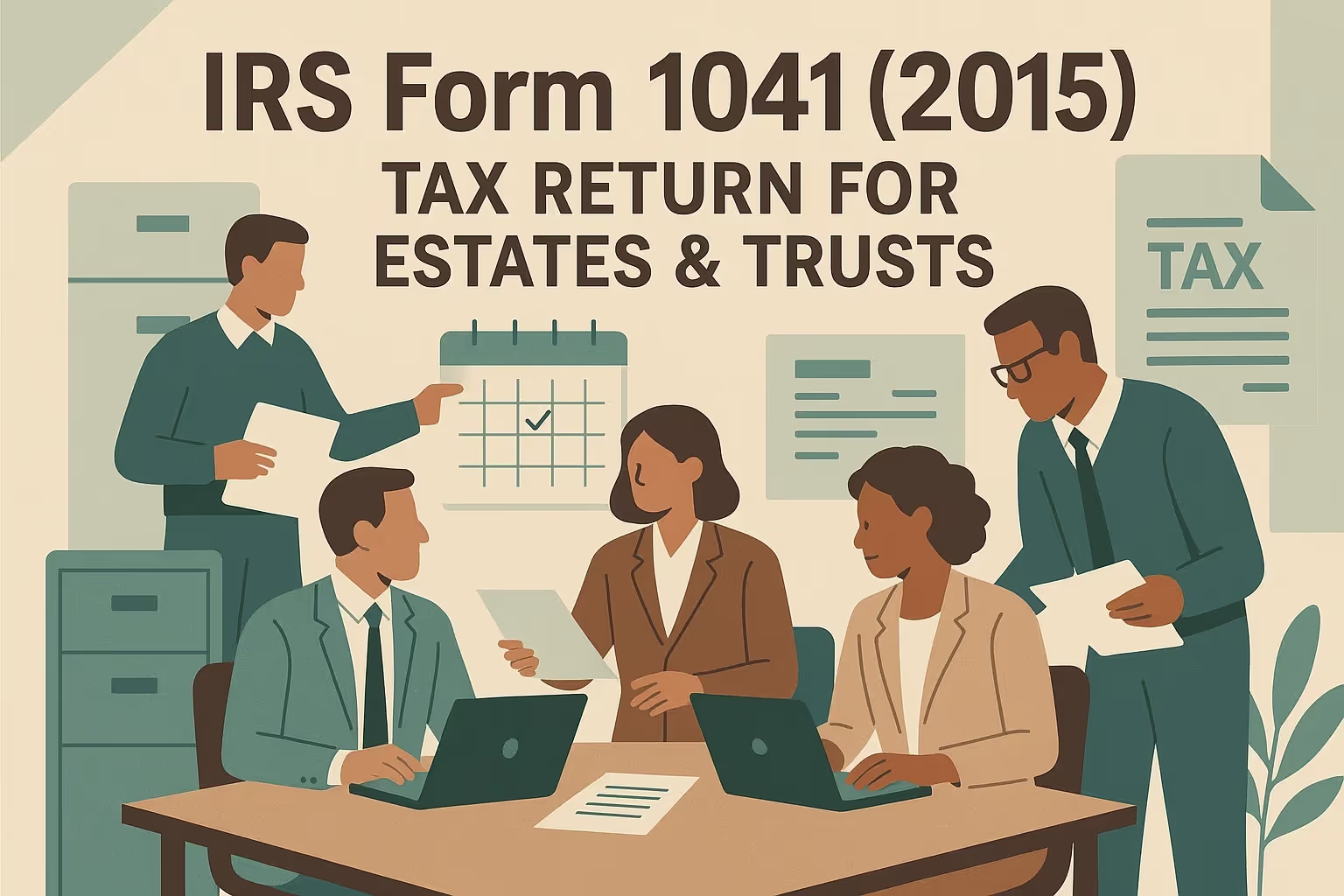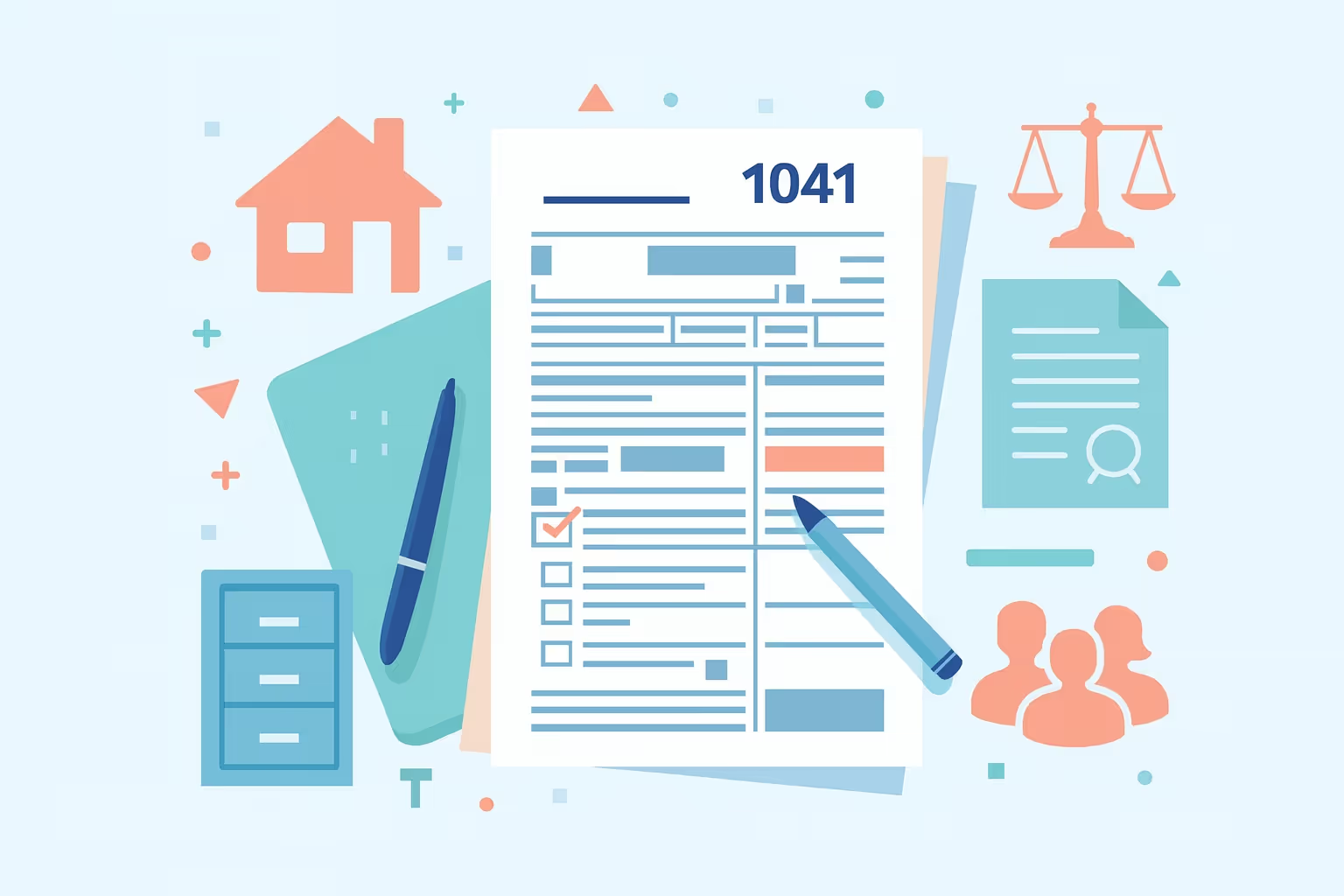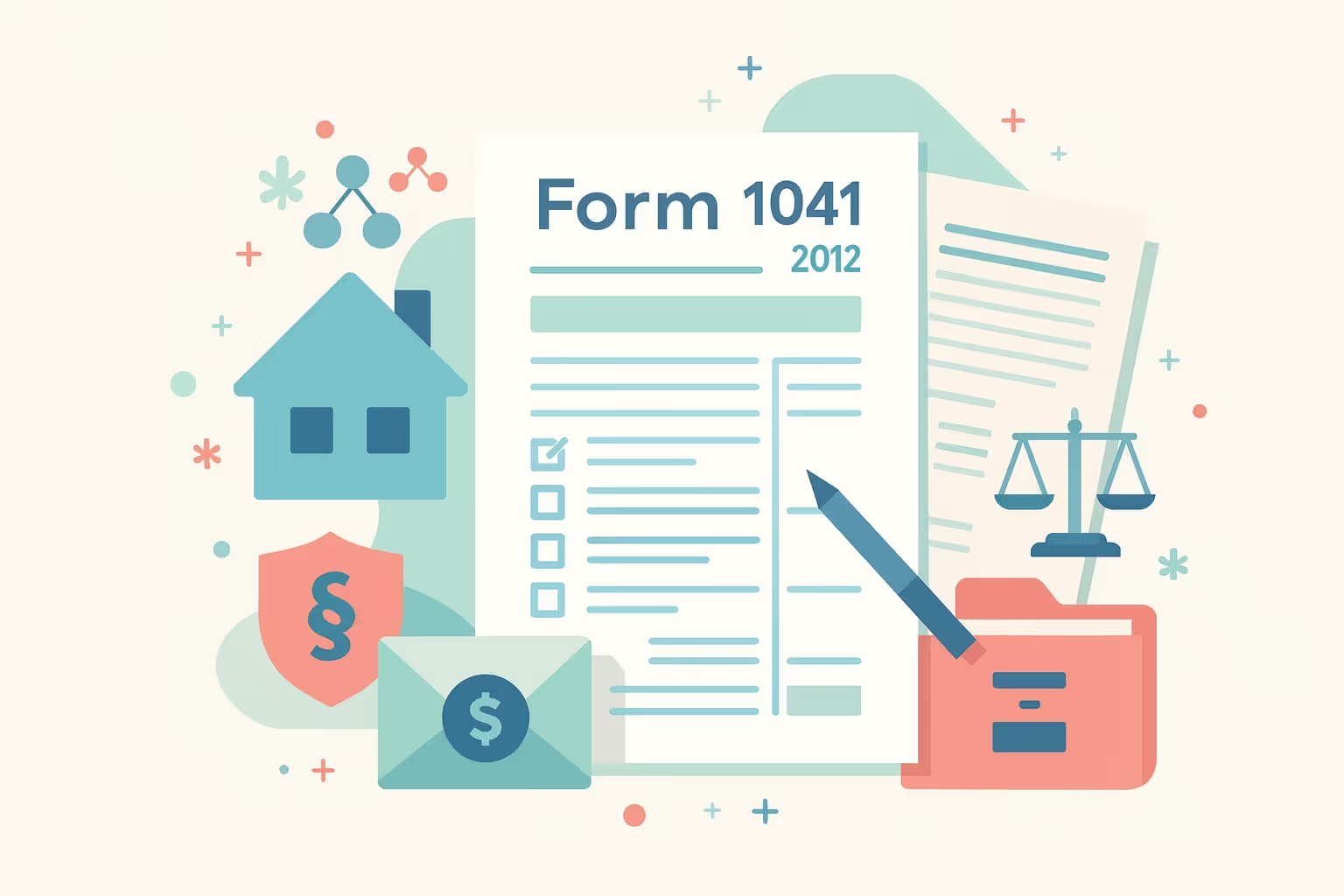How to File Federal Form 1041 for Tax Year 2021
Every year, thousands of fiduciaries file a federal Form 1041 for tax year 2021 on behalf of estates and trusts—and every year, many face painful penalties for getting it wrong. The Internal Revenue Service (IRS) requires estates with $600 or more in annual gross income, or trusts with any taxable income, to file this income tax return. Missing this obligation can lead to minimum penalties of $435 if the return is more than 60 days late, plus interest that grows until payment is made.
Filing correctly and on time is more than just a legal requirement: it’s a financial safeguard. Paper filing can take eight weeks or longer to process, delaying refunds and prolonging beneficiary distributions. Errors, such as misreporting capital gains or failing to prepare Schedule K-1 forms, can lead to costly audits or IRS notices. By contrast, filing electronically is faster, typically processed within 2–3 weeks, and confirms receipt—an advantage that can save time and stress for estate administrators and trustees.
This guide is designed to help you file confidently, whether you are managing a decedent’s estate, a simple trust, or a complex trust. You’ll find step-by-step instructions for gathering records, reporting income categories, calculating the income distribution deduction, and preparing beneficiary statements. By the end, you will understand how to file Form 1041, minimize income tax liability, avoid penalties, and accurately complete your fiduciary duties.
Understanding Federal Form 1041
Before you can begin filing, it is essential to understand the form's purpose and why the IRS requires it. This section explains the purpose of Form 1041, who must file it, and the key terms you will encounter.
What Is Form 1041 and Who Must File
Form 1041, officially titled Form 1041 U.S. Income Tax Return for Estates and Trusts, is the income tax return that reports income, deductions, and credits for estates and trusts. It calculates the estate’s taxable income and the resulting income tax liability. Fiduciaries must file Form 1041 if the estate or trust meets any of the following:
- Estates: You must file if the estate generates $600 or more in annual gross income or if there is even one nonresident alien beneficiary. This includes income from designated assets such as savings accounts, mutual funds, or rented property.
- Trusts: You must file if the trust generated any taxable income, has $600 or more in total revenue, or has a nonresident alien beneficiary.
This form applies to many entities: decedent’s estate, simple and complex trusts, grantor trusts, bankruptcy estates, and pooled income funds. Filing ensures that all income categories reported are properly taxed and distributed according to the law.
Key Terms You Need to Know
Understanding a few critical terms will make the filing process more manageable:
- Distributable Net Income (DNI): This income can be distributed to beneficiaries for tax purposes. It is used to calculate the income distribution deduction, which reduces the estate or trust’s taxable income.
- Estate Calendar Year vs. Fiscal Year Estates: Most estates follow the calendar year, meaning the tax year ends on December 31, and the return is due by the 15th day of the fourth month after year-end. Some choose a fiscal year, which may simplify reporting if the decedent passed mid-year.
- Beneficiary’s Share: Each beneficiary’s share of ordinary income, capital gains, and deductions must be reported on Schedule K-1. These figures directly affect the beneficiary’s personal income tax return.
What’s New for Tax Year 2021
Before filing, you should know about the changes that applied specifically to the 2021 tax year. These updates affected due dates, tax brackets, and certain credits. Understanding these changes will help you avoid errors and use the correct thresholds for tax payment purposes.
Updated Deadlines and Tax Brackets
Due to the Emancipation Day holiday, calendar year estates and trusts were required to file by April 18, 2022, instead of April 15. If the fiduciary was located in Maine or Massachusetts, the deadline was extended to April 19 because of Patriots’ Day.
The IRS also updated tax brackets for estates and trusts. For capital gains, the 2021 thresholds were as follows:
- 0% Bracket: The 0% capital gains rate applies to amounts up to $2,700. This allowed smaller estates and trusts to pay no tax on qualifying gains.
- 15% Bracket: The 15% rate applies from $2,701 to $13,250. This middle tier covered most typical investment sales for estates with moderate income from stocks and securities.
- 20% Bracket: The 20% rate applied to amounts above $13,250. Estates with large capital transactions were required to pay this higher rate on their excess gains.
The bankruptcy estate filing threshold increased to $12,550. This is especially important for fiduciaries managing estates with substantial income-producing assets that could trigger additional reporting requirements.
COVID-19 Related Changes
Congress extended several pandemic-related tax provisions into 2021 that directly affected estates and trusts. Fiduciaries needed to review these updates to ensure proper reporting:
- Employee Retention Credit: This credit was available to qualified employers affected by COVID-19 closures or experiencing significant declines in gross receipts. Claiming this credit could reduce the income tax liability of the estate or trust.
- Qualified Sick and Family Leave Credits: These credits extended coverage for employers that provided paid sick or family leave related to COVID-19. They allowed fiduciaries to offset payroll costs and reduce the overall tax payment obligation.
- PPP Loan Forgiveness: Fiduciaries with forgiven Paycheck Protection Program (PPP) loans were required to meet new IRS reporting standards. Proper documentation was necessary to avoid audit issues and ensure the forgiven amount was excluded from taxable income.
New Reporting Requirements
Several new rules applied in 2021. Fiduciaries needed to pay special attention to these changes:
- Section 1061 Reporting: Recharacterizes certain partnership interest gains for investment services providers from long-term to short-term capital gains unless the three-year holding period is met.
- Business Interest Deduction: Certain estates and trusts with business interest expense must file Form 8990 to calculate the limitation under the Internal Revenue Code.
- Excess Deductions on Termination: Estates and trusts must now classify these deductions as either section 67(e) deductions or non-miscellaneous itemized deductions, which affects how they are reported on beneficiaries’ returns.
Step-by-Step Filing Instructions
This section will guide you through every part of the filing process. Follow these steps carefully to ensure accurate income tax returns and avoid delays or penalties.
Step 1: Gather Required Information
Before you start filling out Form 1041, collect all necessary documents:
- Obtain an Employer Identification Number (EIN): The IRS requires every estate or trust to have an EIN. This number is used for tax reporting and banking and should be obtained before any income is reported.
- Collect Legal Documents: Secure a copy of the will, trust agreement, and prior-year returns. These documents help verify whether the entity is a decedent’s estate, simple trust, or complex trust.
- Gather Financial Records: Collect all 1099s, Schedule K-1s from partnerships, brokerage statements, and bank records. These will show interest income, dividends, capital gains, and other income generated by the estate’s or trust’s designated assets.
- Prepare Beneficiary Information: List each beneficiary’s name, address, and Social Security number. Track all distributions made so you can calculate each beneficiary’s share of income distributed.
Step 2: Complete the Header
Use the legal name of the estate or trust exactly as it appears on the EIN application. For estates, write “Estate of [Decedent’s Name].” Include the fiduciary’s name, title, and mailing address. Check the boxes that apply: initial return, amended return, final return, or change in fiduciary information.
Step 3: Report Income (Lines 1–8)
Accurately reporting all income categories is crucial to determining the estate’s taxable income and calculating the correct income tax liability. Each line on Form 1041 corresponds to a specific type of income and must be completed carefully.
- Line 1 – Interest Income: Report all taxable interest earned from bank accounts, savings accounts, and bonds. This includes interest from certificates of deposit and other income-producing assets.
- Line 2a – Ordinary Dividends: Include all dividends from stocks, mutual funds, and other investments. These amounts must match what is reported on Form 1099-DIV.
- Line 2b – Qualified Dividends: Report dividends that meet the IRS holding period requirements and qualify for lower capital gains tax rates. This distinction is important because it affects the overall tax owed.
- Line 3 – Business Income: If the estate or trust operates a trade or business, report the ordinary business income here. Attach supporting schedules if the business generated significant revenue.
- Line 4 – Capital Gains or Losses: Use Schedule D to report securities, real estate sales, or other assets. Be sure to distinguish between short-term and long-term capital gains, as they are taxed at different rates.
- Line 5 – Rents and Royalties: Include rental income from rented property and royalties from patents, copyrights, or natural resource extraction. Use Schedule E to detail the property and related expenses.
- Line 6 – Farm Income: Report any income from agricultural activities, including crop or livestock sales, on Schedule F. This ensures that farm-related income is taxed correctly and deductible expenses are captured.
- Line 7 – Other Income: Capture any additional taxable income not reported elsewhere. This may include the decedent’s final paycheck, taxable refunds, or miscellaneous gains.
Step 4: Claim Deductions (Lines 10–17)
Deductions lower the total income subject to tax and can significantly reduce the estate’s taxable income. You may deduct:
- Fiduciary fees: They are payments made to the estate executor or trustee for managing the estate or trust. They must be reasonable concerning the work performed and are fully deductible for income tax purposes.
- Professional fees: This includes attorney, accountant, and tax preparer fees. These services are necessary for preparing the return and handling administration, so they are generally deductible under the Internal Revenue Code.
- Property and state taxes: Real estate taxes, state income taxes, and personal property taxes paid by the estate or trust can be deducted. Keeping receipts and proof of payment ensures these deductions are adequately documented.
- Charitable contributions: Donations must be authorized in the governing instrument and paid from gross income. Attach Schedule A to claim this deduction, and include documentation to show that the recipient is a qualified charitable organization.
- Other deductions under section 67(e): Expenses such as safe deposit box fees, costs of maintaining estate property, and legal fees for property protection qualify. These deductions are not subject to the 2% floor for individual taxpayers.
Step 5: Calculate the Income Distribution Deduction (Schedule B)
This step allows you to deduct the income distributed or required to be distributed to beneficiaries. Doing this correctly helps ensure that the taxable income is appropriately reduced and that the tax burden is fairly shared between the estate or trust and its beneficiaries.
- Calculate Distributable Net Income (DNI): Use Schedule B to determine the DNI, which represents the maximum amount of income that can be passed to beneficiaries for tax reporting purposes. This calculation includes interest, dividends, and other income the estate or trust generates.
- Determine Actual Distributions: Review the estate’s or trust’s records to find the total amount distributed during the tax year. You must compare this amount with the DNI to ensure you do not exceed the allowable distribution deduction.
- Apply the Deduction: Deduct the smaller of the DNI or the actual distribution from the estate’s taxable income. This reduces the estate or trust's income tax liability and shifts the tax responsibility to the beneficiaries, who will report the income on their personal returns.
Step 6: Prepare Schedule K-1 for Beneficiaries
Each beneficiary who receives income or allocations must get a Schedule K-1. This document reports the beneficiary’s share of the estate or trust’s income and deductions so they can correctly complete their personal income tax return.
- Ordinary Income and Capital Gains: Clearly list the portion of ordinary income and capital gains allocated to each beneficiary. This ensures that each reports the correct amounts on their return and pays the appropriate taxes.
- Credits, Deductions, and Tax-Exempt Income: Include any tax credits or deductions that pass through to the beneficiary and any tax-exempt income. This allows the beneficiary to claim these items on their return, potentially reducing their income tax liability.
- Foreign Tax Paid: If the estate or trust paid foreign taxes, report each beneficiary’s share. This information may allow them to claim a foreign tax credit and avoid double taxation on income generated outside the United States.
Provide each beneficiary with a copy by the filing deadline so they can include it on their personal income tax return.
Step 7: Compute Tax and Credits (Schedule G)
Calculate the income tax liability based on the tax tables for estates and trusts. Report any estimated tax payments or credits applied during the year. If applicable, include the alternative minimum tax.
Step 8: File and Pay
You may file electronically or by paper. E-filing is recommended for faster processing.
- Processing Time: 2–3 weeks
- Error Rate: Low (automatic checks)
- Refund Speed: Direct deposit available
- Processing Time: 6–8 weeks or more
- Error Rate: Higher (manual entry)
- Refund Speed: Check mailed; longer wait
Payment options include checking or placing a money order with Form 1041-V, Electronic Federal Tax Payment System (EFTPS), credit/debit card payment, or electronic funds withdrawal if you e-file.
Common Mistakes and How to Avoid Them
Even small mistakes on Form 1041 can delay refunds, create IRS notices, or result in penalties. This section highlights fiduciaries' most frequent errors and provides prevention tips.
Filing Requirement Errors
- Many estates fail to file because they mistakenly believe that small income amounts do not require a return. If the estate generates $600 or more in annual gross income, you must file Form 1041 even if there is no taxable income.
- Missing the deadline is another common issue. The due date is the 15th day of the fourth month after the tax year ends, so calendar year estates must file by mid-April. If you need more time, file Form 7004 for an extension before the original due date.
Income and Deduction Errors
- Fiduciaries sometimes omit income from partnerships, rental properties, or the decedent’s final paycheck. Double-check that all income categories reported match the information returns (1099s, K-1s).
- Deductions must be classified correctly. Some expenses, like funeral costs, are not deductible on Form 1041, U.S. income tax return, but belong on the estate tax return (Form 706).
Schedule K-1 Issues
- Failing to prepare a Schedule K-1 for every beneficiary is a frequent mistake. Each beneficiary’s share of income distributed must be reported accurately.
- Incorrect Social Security numbers or addresses on Schedule K-1 can delay beneficiaries’ refunds and cause additional IRS correspondence.
Math and Computation Problems
- Addition or subtraction errors are common when calculating total income and deductions. Use tax software or double-check calculations manually before filing.
- Fiduciaries sometimes use the wrong tax tables, which leads to an incorrect income tax liability. Always use the tax tables for the correct tax year.
Comparison: Failure-to-File vs. Failure-to-Pay Penalties
- Rate: 5% per month
- Maximum Penalty: 25% of unpaid tax
- Key Impact: Penalties accrue quickly and can add hundreds of dollars to the total owed.
- Rate: 0.5% per month
- Maximum Penalty: 25% of unpaid tax
- Key Impact: Interest also accrues on the unpaid balance, increasing the cost over time.
Special Situations
Not all estates and trusts file in the same pattern. Some have exceptional circumstances that require extra attention. This section explains how to handle zero-activity estates, fiscal year estates, and foreign beneficiaries.
Zero-Activity or Dormant Estates
Even if an estate had little or no activity during the year, you may still need to file.
- Minimum Filing Requirement: You must file Form 1041 if the estate generated $600 or more in annual gross income. This applies even if there were no distributions or the estate had no taxable income.
- Filing with Zero Income: You should still complete the form by entering “0” on the income lines when there is no income. You must also prepare Schedule B and Schedule K-1 for beneficiaries, even if they show zero amounts.
- Deductible Administrative Costs: Fiduciary fees, tax preparation fees, and expenses to maintain estate property can still be deducted during inactive years. Filing allows you to claim these costs and keep a proper tax history.
Fiscal Year Estates
Some estates do not use the calendar year.
- Choosing a Fiscal Year: An estate can adopt a fiscal year ending on the last day of any month within 12 months after the decedent passed. This can simplify accounting by aligning the tax year with the estate’s administrative cycle.
- Filing Deadline: Returns for fiscal year estates are due on the 15th day of the fourth month after the fiscal year ends. This gives the estate administrator or trustee extra time to gather records and prepare the return.
Foreign Trusts and Beneficiaries
Special reporting applies when there is a foreign element.
- Foreign Trusts: U.S. owners of foreign trusts may have to file additional forms such as Form 3520 or Form 3520-A. These forms report trust ownership and transactions to the IRS.
- Nonresident Alien Beneficiaries: You must file Form 1041 if there is a nonresident alien beneficiary, regardless of income amount. In addition, withholding requirements and reporting obligations may apply to the beneficiary’s share of income distributed.
First-Time Filer Tips
If you are filing Form 1041 for the first time, it is normal to feel overwhelmed. The following tips will help you stay organized, avoid errors, and meet all IRS requirements.
Fiduciary Responsibilities
As the estate executor, personal representative, or trustee, you are legally responsible for managing the estate’s finances. You must report income, pay taxes on time, and act in the best interests of beneficiaries. Failing to meet these duties can result in personal liability for unpaid taxes or penalties.
Record-Keeping Best Practices
Maintaining accurate records is essential for preparing and defending the return in case of an IRS audit.
- Track All Income and Expenses: Keep detailed logs of interest, dividends, and rental income, along with invoices and receipts for expenses. This ensures that all reported income categories match the supporting documentation.
- Maintain Beneficiary Communications: Document all distributions and communications with beneficiaries. Clear records reduce disputes and support the amounts reported on Schedule K-1.
- Organize Financial Statements: Store bank statements, brokerage statements, and prior returns together. This makes verifying annual gross income easier and calculating distributable net income accurately.
When to Seek Professional Help
Sometimes hiring a professional is the most cost-effective choice.
- Complex Estates: If the estate owns a business, holds significant investments, or has multiple beneficiaries, consider working with a CPA or tax attorney. They can ensure compliance with the Internal Revenue Code and help maximize deductions.
- International Issues: If there are foreign trusts, overseas assets, or nonresident alien beneficiaries, seek specialized advice. These situations often require additional IRS forms and careful tax planning.
- Time Constraints: If you cannot prepare the return by the deadline, a professional can help you file Form 7004 for an extension and avoid late-filing penalties.
Frequently Asked Questions (FAQs)
What happens if I miss the filing deadline?
If you miss the due date, file as soon as possible to reduce penalties. The IRS charges a 5% failure-to-file penalty for each month the return is late, up to 25% of the unpaid tax. If the return is over 60 days late, the minimum penalty is $435 or the income tax liability, whichever is less. Paying promptly limits interest charges and helps avoid additional collection actions.
Can I get an extension to file Form 1041?
Yes, you can file Form 7004 to request an automatic 5½-month extension. This extension applies to the return itself, not to paying income tax, so any taxes owed must still be paid by the original due date. Filing for an extension prevents the failure-to-file penalty and gives more time to review income categories reported and prepare accurate deductions and credits.
What expenses can I deduct on Form 1041?
You can deduct fiduciary fees, attorney and accountant fees, property taxes, and expenses related to maintaining income-producing assets. Charitable contributions authorized in the governing document are also deductible if reported on Schedule A. These deductions help reduce the estate’s taxable income and can lower the overall tax payment burden, ensuring that beneficiaries receive the most significant possible distributions.
How do I report capital gains and losses?
Report capital gains and losses on Schedule D, detailing short-term and long-term transactions separately. Estates with mutual funds or large asset sales must use the correct 2021 capital gains brackets to calculate tax owed. Gains increase total income, while losses may offset other income. Accurate reporting is crucial because these amounts affect the estate’s tax and the beneficiary’s share on Schedule K-1.
When do beneficiaries receive Schedule K-1?
Beneficiaries must receive Schedule K-1 by the same date the fiduciary must file Form 1041, including any extensions. This ensures beneficiaries can prepare their personal income tax return correctly and report their share of income distributed. Late or missing K-1s can delay beneficiary refunds and may cause IRS matching notices. Providing timely and accurate K-1s helps keep beneficiaries’ tax situations in compliance.






